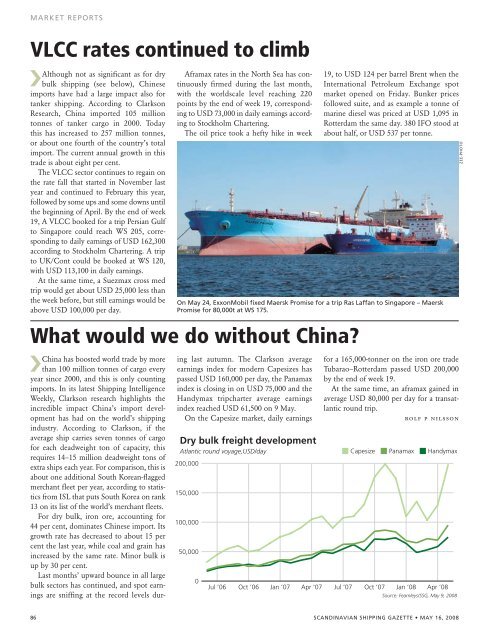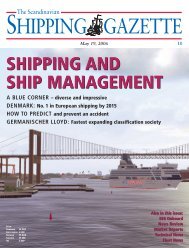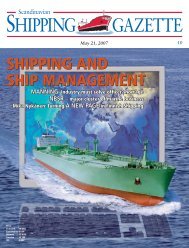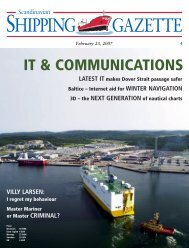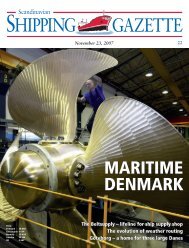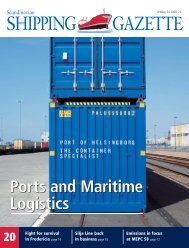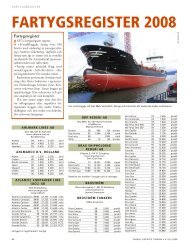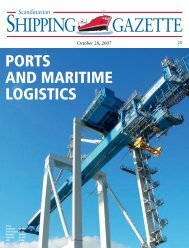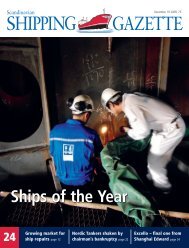SSG No 10 - Shipgaz
SSG No 10 - Shipgaz
SSG No 10 - Shipgaz
- TAGS
- shipgaz
- shipgaz.com
Create successful ePaper yourself
Turn your PDF publications into a flip-book with our unique Google optimized e-Paper software.
MARKET REPORTS<br />
VLCC rates continued to climb<br />
Although not as significant as for dry<br />
bulk shipping (see below), Chinese<br />
imports have had a large impact also for<br />
tanker shipping. According to Clarkson<br />
Research, China imported <strong>10</strong>5 million<br />
tonnes of tanker cargo in 2000. Today<br />
this has increased to 257 million tonnes,<br />
or about one fourth of the country’s total<br />
import. The current annual growth in this<br />
trade is about eight per cent.<br />
The VLCC sector continues to regain on<br />
the rate fall that started in <strong>No</strong>vember last<br />
year and continued to February this year,<br />
followed by some ups and some downs until<br />
the beginning of April. By the end of week<br />
19, A VLCC booked for a trip Persian Gulf<br />
to Singapore could reach WS 205, corresponding<br />
to daily earnings of USD 162,300<br />
according to Stockholm Chartering. A trip<br />
to UK/Cont could be booked at WS 120,<br />
with USD 113,<strong>10</strong>0 in daily earnings.<br />
At the same time, a Suezmax cross med<br />
trip would get about USD 25,000 less than<br />
the week before, but still earnings would be<br />
above USD <strong>10</strong>0,000 per day.<br />
China has boosted world trade by more<br />
than <strong>10</strong>0 million tonnes of cargo every<br />
year since 2000, and this is only counting<br />
imports. In its latest Shipping Intelligence<br />
Weekly, Clarkson research highlights the<br />
incredible impact China’s import development<br />
has had on the world’s shipping<br />
industry. According to Clarkson, if the<br />
average ship carries seven tonnes of cargo<br />
for each deadweight ton of capacity, this<br />
requires 14–15 million deadweight tons of<br />
extra ships each year. For comparison, this is<br />
about one additional South Korean-flagged<br />
merchant fleet per year, according to statistics<br />
from ISL that puts South Korea on rank<br />
13 on its list of the world’s merchant fleets.<br />
For dry bulk, iron ore, accounting for<br />
44 per cent, dominates Chinese import. Its<br />
growth rate has decreased to about 15 per<br />
cent the last year, while coal and grain has<br />
increased by the same rate. Minor bulk is<br />
up by 30 per cent.<br />
Last months’ upward bounce in all large<br />
bulk sectors has continued, and spot earnings<br />
are sniffing at the record levels dur-<br />
Aframax rates in the <strong>No</strong>rth Sea has continuously<br />
firmed during the last month,<br />
with the worldscale level reaching 220<br />
points by the end of week 19, corresponding<br />
to USD 73,000 in daily earnings according<br />
to Stockholm Chartering.<br />
The oil price took a hefty hike in week<br />
19, to USD 124 per barrel Brent when the<br />
International Petroleum Exchange spot<br />
market opened on Friday. Bunker prices<br />
followed suite, and as example a tonne of<br />
marine diesel was priced at USD 1,095 in<br />
Rotterdam the same day. 380 IFO stood at<br />
about half, or USD 537 per tonne.<br />
On May 24, ExxonMobil fixed Maersk Promise for a trip Ras Laffan to Singapore – Maersk<br />
Promise for 80,000t at WS 175.<br />
What would we do without China?<br />
ing last autumn. The Clarkson average<br />
earnings index for modern Capesizes has<br />
passed USD 160,000 per day, the Panamax<br />
index is closing in on USD 75,000 and the<br />
Handymax tripcharter average earnings<br />
index reached USD 61,500 on 9 May.<br />
On the Capesize market, daily earnings<br />
200,000<br />
150,000<br />
<strong>10</strong>0,000<br />
50,000<br />
0<br />
for a 165,000-tonner on the iron ore trade<br />
Tubarao–Rotterdam passed USD 200,000<br />
by the end of week 19.<br />
At the same time, an aframax gained in<br />
average USD 80,000 per day for a transatlantic<br />
round trip.<br />
rolf p nilsson<br />
Dry bulk freight development<br />
Atlantic round voyage,USD/day ■ Capesize ■ Panamax ■ Handymax<br />
Jul ’06<br />
Oct ’06<br />
86 SCANDINAVIAN SHIPPING GAZETTE • MAY 16, 2008<br />
Jan ’07<br />
Apr '07<br />
Jul ’07<br />
Oct ’07<br />
Jan ’08<br />
Apr ’08<br />
Source: Fearnleys/<strong>SSG</strong>, May 9, 2008<br />
ZEE-PHOTO


